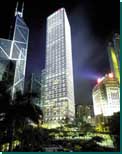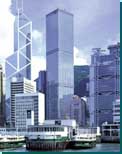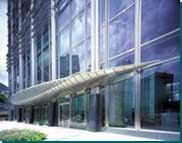| April
2000 |


|
|
|
Cheung Kong Center
Prestige
"Prestige: respect
or reputation derived from achievements, power, associations, etc."
-- The Pocket Oxford Dictionary
An intangible yet highly
desirable quality, "Prestige" is avidly sought by Hong
Kong building professionals as the ultimate tag for their creations.
Yet, as the above definition shows, prestige is not easily acquired
and simply appended -- it is the end-product of an evolutionary
process. "Respect and reputation" are two qualities that
Cheung Kong Holdings possesses in abundance, derived in large part
from Chairman Li Ka-shing's extensive property developments (and
less-heralded philanthropic work) in the HKSAR and on the mainland.
Cheung Kong Center -- a 62-storey office tower -- occupies a prime
site, sandwiched between Norman Foster's Hongkong Bank Building
and IM Pei's Bank of China Building. When the term "Prestige"
is applied to buildings, it is difficult to present a more worthy
candidate
 For
the last four years, the Leo A Daly (LAD) team in Hong Kong has
been working on a single building. Leo A Daly, the third largest
architecture/engineering firm in the US, served as Prime Architect
for Cheung Kong Center (CKC). The global design team united several
prominent firms: design consultants Cesar Pelli & Associates,
structural engineers Ove Arup & Partners, landscape consultants
Belt Collins, lighting designers HM Brandston & Partners, and
engineers Flack & Kurtz and Parsons Brinckerhoff & Associates. For
the last four years, the Leo A Daly (LAD) team in Hong Kong has
been working on a single building. Leo A Daly, the third largest
architecture/engineering firm in the US, served as Prime Architect
for Cheung Kong Center (CKC). The global design team united several
prominent firms: design consultants Cesar Pelli & Associates,
structural engineers Ove Arup & Partners, landscape consultants
Belt Collins, lighting designers HM Brandston & Partners, and
engineers Flack & Kurtz and Parsons Brinckerhoff & Associates.
CKC's location
-- between the Bank of China and HSBC towers -- is one of the more
conspicuous sites in Central. The Hong Kong Hilton used to be here,
but the desire for a flagship office tower in this precise location
superseded even the need for a five-star hotel. Although Cheung
Kong -- in collaboration with the Land Development Corporation -
was already involved in developing The Center further west, the
site was just too good to ignore. The Hilton was razed in 1995 and
plans to erect an office tower were mooted.
The height for
the new tower was specified at 290 metres to keep with the glide
plane between the Bank of China and HSBC towers. LAD's design philosophy
for Cheung Kong Center grew out of the idea of taking the old Hilton
hotel site and amalgamating it with Beaconsfield House and the carpark
behind. LAD worked closely with Pelli to design the unique curtain
wall and to determine the tower's architectural relationship with
the Bank of China and the Hong Kong Shanghai Bank towers. The Daly
team also designed the tower's glass and stainless steel base, its
lobby and public interiors, and the pedestrian-friendly urban landscape
linking it with its neighbours, among them some of Hong Kong's most
historic public buildings and grounds. Three key design issues informed
their vision: the maximisation of available square footage on each
floor, the appearance of the tower's simple, classic form in a complex
context, and the character and connectivity of the important public
spaces at the tower's base.
An oasis with
facilities
Around the base, stepped gardens form a man-made expression of the
powerful slope of the Peak, which comes to level-grade at Queen's
Road. Crafted in stone, water, and exotic plantings, the gardens
recall Hong Kong's harbor and verdant natural palette -- a shimmering,
tropical environment complementary to the reflective glass and luminous
stainless-steel skin of the tower.
LAD's site planning
needed to integrate a number of facilities on the site -- for example,
a public toilet and a post office. How to integrate and implement
these facilities with the design as a whole represented another
challenge for the design team.
At the tower's
base, over two acres of public space include the lobby, gardens,
a post office, public restrooms, and circulation for both cars and
pedestrians. The tower's landscape also provides cross-site access
to many neighbouring destinations, politely offering the citizens
of Hong Kong pathways rather than obstacles. Ray Zee -- Design Director
on the project since its inception four years ago -- credits this
civic-minded foresight to Cheung Kong's long standing in the community:
"I think that Cheung Kong as a group wanted to give something
back to the city, on this site with so much potential. They could
have put up a 'concrete jungle' but they didn't -- they took the
time to consult with us and the landscape architect.
"We located
the new carpark under the ground in order to create a park landscape
with water features and lots of greenery. Cheung Kong Center can
be considered an oasis in Central."
Situating the
tower
Given the prominence of the site, it was clear that the design team
would exercise great care in placement of the structure. The project
had to respond to the neighbouring buildings -- the aforementioned
Bank of China and HSBC towers, St John's Cathedral, the former French
Mission (now the Court of Final Appeal) and Citibank Plaza. As LAD
didn't want to create any settling problems, they had Ove Arup Geotechnical
oversee the project to ensure that what had been constructed in
the 19th century wouldn't be disturbed. The final placement is the
result of first respecting the surroundings, then creating the right
orientation and siting so that everything was complementary.
The LAD team eschewed
the typical "harbour view/mountain view" scenario. CKC
is sited to present two views toward the harbour, one spectacular
view looking up towards The Peak and another view facing Western.
The siting takes better advantage of the views than a typical north/south
orientation.
The resultant tower
is resolutely square -- an unblemished rectangular pillar. Not only
does it hark back to more traditional architectural forms, but it
contrasts with its (far) more angular neighbours. The square plan
represents the most efficient use of space. The client wanted a
timeless and elegant building, with a simple shape which dovetails
into curtain wall.
The curtain
wall and the grid
Cheung Kong Center's curtain wall scheme is highly specific. From
afar, the building appears seamless, but as you approach, you discover
that detail is added through a system of grids. The curtain wall
is based on a 7.2-metre grid which breaks down into a sub-grid which
is highlighted by fibre optics at night, adding a level of detail
and sophistication as you get closer to the wall.
Steel as a
fabric
The curtain wall is executed in 'linen steel" which was also
used on London's Canary Wharf project and KL's Petronas Towers.
This cladding has a chatoyant quality -- when lit by the sun, it
gives off a glow which serves as a highlight for the curtain wall.
Many of the cladding members are curved, allowing the curtain wall
to 'track' the sun as it passes, giving highlights to the building
during the daytime.
A new material,
linen steel is only one component of the sophisticated curtain wall
system. The system is able to withstand severe wind-loads of minus-seven
kPa. At the base, high-performance glazing from Viracon is used.
The glass panels (custom-made due to their large sizes) provide
up to 100 per cent light transmittance but block out 75 per cent
of the UV light, permitting clear vistas up Queen's Road or up Chater
Garden without admitting a great amount of heat. In addition to
the UV-screening benefits, the glazing insulates sound as well;
at the lower floors, street noise is barely audible.
The glass core
The steel-and-glass enclosure showcases a spectacularly illuminated
interior-core wall. The LAD design team went through at least twenty
different suppliers while searching for the right glass to execute
this design vision. Their 'glass core' concept is intended to bring
elegance and simplicity to Cheung Kong Center, as well as a sense
of the future. The concept contributes to Cheung Kong Center's balance
of ethereality and substance. The design team wanted the core to
read as a glass structure -- rather than a bulky core, an all-glass
encased skin core without frames was used.
The entire building
acts as a tool to make the glass brighter, which means that the
composition of the glass was critical. Two types of glass were used,
one with a sea-shell pattern, highlighted with dichroic glass --
a treated, coated piece of glass which keys on the spectrum of available
light. The latter enhances the light play of the structure -- from
one end of the building to the other, you see reflected light ranging
from the blue spectrum to the red spectrum.
Fibres and
floods
Cheung Kong Center softly glows in the night hours, presenting a
unique addition to its particular patch of the world-famous Hong
Kong skyline. To accomplish this, fibre-optic lighting was employed.
This scheme not only provides very even lighting but makes it easy
to change the overall lighting scheme; by simply changing the bulb
in the ceiling, a new lit facade is easily achieved. Fibre-optic
lighting is nothing new in the world of hi-tech or telecoms but
is a new and welcome trend in terms of building decoration.
In addition to
the fibre-optics, the exterior lighting system uses a series of
floodlight scoops that are aimed upward. The floods bathe the building
in a white light at nighttime and are used in unison with a fibre-optic
system that has colour-changing capability, but for the most part
will remain white-on-white. The floodlights are for closer views,
the fibre optics for long distance views. As you get further and
further away from Central, the fibre-optics are what make the building
'read', rather than the floodlights.
A beatific lighting
touch known as a 'halo' was added by the design team. At the very
top of the tower, to complement the lighting at the base (a backlit
core), and the curtain wall (an exterior lit core), there is a 'halo'
This halo effect is achieved by shooting special studio lights across
the underside of the roof. A curved panel surrounds the top of the
tower and caps off the building.
The lobby
At 16 metres high -- the equivalent of four stories -- the main
lobby invites pedestrians into the building. The vertical thrust
of this lobby gives an impression of reaching for the stars, and
the lighting accents above the lifts (triple translucent extended
ovals that fire up with a yellow glow to announce lift arrival)
lend a classy sci-fi look (think Forbidden Planet rather than
Bladerunner). These accents are echoed in the upper ground
floor lift lobby, which is accessed by escalator or staircase.
 Building
services Building
services
Cheung Kong Center offers 53 office floors with a total GFA of 102,190
sq m. The column-free floorplates average 1,720 sq m.
Cheung Kong Center's
building services reflect the superb quality of the building. The
building is equipped with a Totally Adaptive Air-conditioning System
(TAAS) -- the entire raised floor is an air-conditioned plenum.
Individual FTPUs (Fan Powered Terminal Units) are variable air volume
control devices which mix cold air from the plenum with return air
from the office. The FTPUs can be individually controlled to suit
personal requirements and allow maximum flexibility. Perimeter FTPUs
are also equipped with electric heaters. When offices need restructuring,
TAAS affords a high degree of flexibility to modify internal layouts,
accommodate organisational changes and expand technological requirements
at low cost with little time or effort.
A total of 28 passenger
lifts serve the building from the ground floor lobby and the upper
ground floor lobby. At nine metres per second, LAD says that these
are the fastest elevators in Hong Kong. The passenger lifts provide
news and information via in-car LCD screens, and two service lifts
serve all floors from the basement loading area.
A long term
view
Zee has nothing but praise for his client's foresight on the project.
"Cheung Kong and Hutchison have taken a proactive long term
view with this project. They put up what I consider an outstanding
flagship building and they have really thought of everything. For
example, in terms of building maintenance, the client has thought
of what's going to be needed for the first few decades of the new
millennium.
"An architectural
project of this calibre doesn't come along very often. And you certainly
don't want to be testing ideas on such an important site. Cheung
Kong and Hutchison allowed us the time to really study the site,
which allowed us the time to come up with the right solution and
set up what was right for the program.
"On a side
note, the most enjoyable aspect of this project is the people involved
on the project, especially the people on site. It hasn't been a
typical project where people complain about how they cannot do something.
Everyone that's been on site has had the attitude of 'Let's all
help to realise this vision? Everyone's been more than helpful,
meeting you more than halfway, and I think everyone involved is
proud to have worked on this building."
For more information on Cheung
Kong Center, http://www.cheungkongcenter.com
is where to point your browser.
developer Hutchison
Whampoa Property Group
prime architect Leo
A Daly
design architects Leo
A Daly with Cesar Pelli Associates
main contractor Paul
Y. - Downer Venture
m&e Flack
& Kurtz/Parsons Brinckerhoff
curtain wall Permasteelisa
lighting designer HM
Brandston & Partners
quantity surveyor Levett
& Bailey Chartered Quantity Surveyors Ltd
lifts & escalators
Ryoden Lift and Escalator Co Ltd
fire services Guardian
Fire Engineers and Consultants Ltd
landscape architect
Belt Collins Hong Kong Ltd
|

 For
the last four years, the Leo A Daly (LAD) team in Hong Kong has
been working on a single building. Leo A Daly, the third largest
architecture/engineering firm in the US, served as Prime Architect
for Cheung Kong Center (CKC). The global design team united several
prominent firms: design consultants Cesar Pelli & Associates,
structural engineers Ove Arup & Partners, landscape consultants
Belt Collins, lighting designers HM Brandston & Partners, and
engineers Flack & Kurtz and Parsons Brinckerhoff & Associates.
For
the last four years, the Leo A Daly (LAD) team in Hong Kong has
been working on a single building. Leo A Daly, the third largest
architecture/engineering firm in the US, served as Prime Architect
for Cheung Kong Center (CKC). The global design team united several
prominent firms: design consultants Cesar Pelli & Associates,
structural engineers Ove Arup & Partners, landscape consultants
Belt Collins, lighting designers HM Brandston & Partners, and
engineers Flack & Kurtz and Parsons Brinckerhoff & Associates.
 Building
services
Building
services